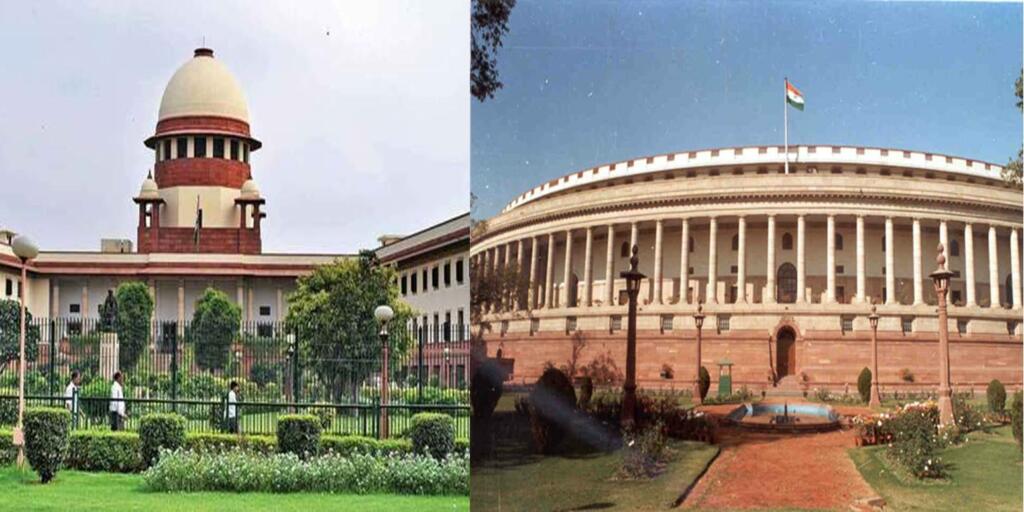After violence broke out against the Hindu community on Hanuman Janamotsav last week in Delhi’s Jahangirpuri area – the North Delhi Municipal Corporation (NDMC) on Wednesday (April 20) started a two-day demolition drive amid strong police presence to rid the area of illegal structures and encroachments. However, a couple of hours into the drive, the Supreme Court ordered the authorities to maintain the status quo and stayed the drive.
Reportedly, the bench, headed by Chief Justice of India (CJI) NV Ramana, hearing the case to stop the demolition, filed by Jamiat Ulama-i-Hind remarked, “Maintain status quo. List before appropriate bench tomorrow.”
Supreme Court orders status quo on demolition drive in north Delhi's #Jahangirpuri. Matter was mentioned before CJI NV Ramana by Senior Advocate Dushyant Dave. CJI orders that status quo be maintained and scheduled a hearing for tomorrow. pic.twitter.com/gglx7ho6yr
— All India Radio News (@airnewsalerts) April 20, 2022
While the case was being heard in the court, the demolition drive continued. Videos of the same have gone viral on social media platforms where NDMC officials could be seen guiding the bulldozers to raze the illegal shops and structures hogging the space on pavements and roads.
Read More: Jahangirpuri rioters picked up guns to ‘protect their community’
NDMC carried out a demolition drive against the illegal constructions & encroachments in Jahangirpuri; at least 30 illegal structures were razed today.
Take a look at this ground report by @priyanktripathi pic.twitter.com/ghKb8xP1zX
— TIMES NOW (@TimesNow) April 20, 2022
Brinda Karat attempts to be the enforcer
Moreover, in what came as a rather peculiar development, it was no NDMC official that came with the written Supreme Court order but CPI(M) leader Brinda Karat. Reportedly, while the demolition drive was underway the CPI(M) Polit Bureau member reached Jahangirpuri and forcefully attempted to implement the Supreme Court decision by asking the authorities to stop the demolition process immediately.
However, the Delhi police asked the controversial Communist leader to vacate the demolition site and not create any chaos. Quoted as saying by ANI, Karat remarked, “At 10:45 am, the SC gave the order to maintain the status quo on the demolition drive, I have come here for the implementation of the order.”
At 10:45 am, the SC gave the order to maintain the status quo on the demolition drive, I have come here for the implementation of the order: CPIM leader Brinda Karat in Jahangirpuri pic.twitter.com/ZoMszwyl84
— ANI (@ANI) April 20, 2022
Karat or her party do not have the power, nor the jurisdiction to force the authorities to do anything. And yet, her actions suggested that she was acting on behalf of the Supreme Court. It would be interesting to note if Supreme Court takes cognizance of this particular issue during the hearing tomorrow or not.
NDMC was simply trying to clear the pavement and roads
While the Supreme Court was swayed to stay the demolition drive, media reports suggest that NDMC was merely attempting to clear pavements, footpaths and roads that have been “illegally occupied”. However, the petitioners once again gave it a communal flip and managed to find their way.
NDMC officials were quoted as saying by The Print, “The two-day drive starts around Wednesday noon. It is being done by the anti-encroachment wing of the municipal corporation. It is only supposed to clear pavements, footpaths and roads of illegal encroachment. The locality (Jahangirpuri) has a scrap market and most pavements and roads, especially around the market area, have been illegally occupied by shops.”
Read More: Delhi Police Commissioner calls out the bluff of Liberals on the Jahangirpuri riots
SC blurring the lines between judiciary and legislature?
Amidst the entire kerfuffle, questions are being cast on the credibility of the apex court. When there are millions and millions of cases pending and petitioners receive their hearing dates, once in a blue moon, the Muslim community was granted a hearing on an emergency basis. To top it all off, their case was heard by none other than the CJI of the country. Surely, the CJI had more pressing cases to attend to than a minor encroachment drive.
In recent times, there has been a pattern where courts across the country have opened their gates overnight to hear the cases when rioters, terrorists or their property is involved. Social media chatter suggested that even if there was no petition filed to stay the demolition, the Supreme Court would have taken a Suo-moto cognizance and done the same.
Judicial adventurism/activism needs to stop
Moreover, even after passing the order, the Supreme Court did not initiate the government through proper channels about its decision. The delay in communication and the language of the decision meant that for good two-three hours, the social media echo chambers, as well as authorities on the ground, remained confused. At one point, NDMC Commissioner Raja Iqbal Singh said that the civic body had not received a copy of the order and, hence, would continue its action.
The decision of SC to interfere in the daily day-to-day working of the government or legislature once again raises the question on the overarching powers of the judiciary. The last few years have seen the Indian judiciary embark on judicial adventurism more repeatedly.
Frequent interventions by the judiciary, which sometimes border on judicial adventurism, tend to weaken the functioning of the other two branches of the constitution. If the trend continues, Jahangirpuri may very well become the flashpoint between the Judiciary and the Government.
